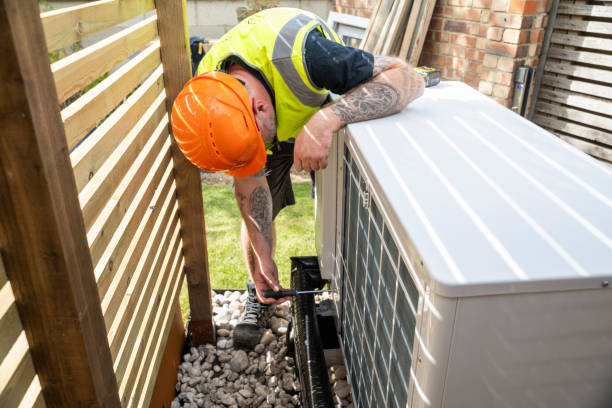Heat Pump Installation in Bloomingdale, FL

For Bloomingdale, FL homeowners, professional heat pump installation delivers year-round comfort and energy efficiency. Heat pumps excel in humidity control, offering a greener alternative to traditional systems in Florida's climate. The page details key advantages, various system types (air-source, ductless mini-splits), and a meticulous installation process. This includes consultation, precise sizing, expert setup, calibration, and customer orientation. Choosing professional installation ensures optimal performance, longevity, and significant energy savings for your home.

Professional Heat Pump Installation in Bloomingdale, FL
For homeowners in Bloomingdale, Florida, achieving consistent indoor comfort throughout the year presents a unique challenge. The long, humid summers demand powerful cooling, while occasional winter cold snaps require reliable heating. A modern heat pump system is an exceptionally effective and energy-efficient solution designed to handle both needs in a single, streamlined unit. Opting for a professional heat pump installation means investing in year-round comfort, superior humidity control, and significant long-term energy savings.
The Decisive Advantages of a Heat Pump in the Florida Climate
While traditional HVAC systems pair an air conditioner with a furnace, a heat pump offers a more integrated and efficient approach perfectly suited for the Bloomingdale climate. Instead of generating heat, it cleverly moves it. In the summer, it pulls heat from inside your home and transfers it outdoors. In the winter, it reverses the process, extracting ambient heat from the outside air and moving it inside to warm your home.
This innovative process delivers several key benefits:
- Exceptional Energy Efficiency: Heat pumps are renowned for their efficiency. Their performance is measured by a Seasonal Energy Efficiency Ratio (SEER) for cooling and a Heating Seasonal Performance Factor (HSPF) for heating. Higher ratings mean lower energy consumption and reduced utility bills year-round. Because they move heat rather than create it through combustion, they can be significantly more efficient than traditional electric furnaces.
- Superior Dehumidification: Florida’s high humidity is a primary source of discomfort. Modern heat pumps excel at removing excess moisture from the air as they cool, creating a more comfortable and healthier indoor environment that feels cooler at higher temperature settings.
- Year-Round Convenience: With a heat pump, a single system manages both your heating and cooling. This simplifies maintenance and operation, providing a seamless transition between seasons with a simple adjustment of your thermostat.
- Environmentally Conscious Choice: By using electricity to move heat instead of burning fossil fuels, heat pumps offer a greener alternative to traditional furnaces, reducing your home’s carbon footprint.
Selecting the Right Heat Pump for Your Bloomingdale Residence
Choosing the correct type and size of heat pump is critical for maximizing efficiency and comfort. Several options are available, with some being particularly well-suited for homes in the area.
- Air-Source Heat Pumps: This is the most common and practical type for the Florida climate. These systems consist of an indoor air handler and an outdoor unit. They are highly efficient, reliable, and capable of handling both the cooling demands of summer and the heating needs of our mild winters.
- Ductless Mini-Split Heat Pumps: An excellent solution for homes without existing ductwork, for new additions, or for creating specific comfort zones within a larger house. A ductless system features one outdoor unit connected to one or more indoor units, each with its own thermostat. This allows for customized temperature control in different rooms, preventing energy waste by only conditioning occupied spaces.
- Geothermal and Hybrid Systems: While less common, geothermal systems use the stable temperature of the earth to transfer heat, offering unparalleled efficiency. Hybrid or dual-fuel systems pair an electric heat pump with a gas furnace, automatically switching to the most efficient fuel source based on outdoor temperatures.
The Professional Heat Pump Installation Process Explained
A successful heat pump installation is a precise, multi-step process that ensures your system performs optimally from day one. A professional installation follows a meticulous plan to guarantee safety, efficiency, and longevity.
Step 1: In-Depth Consultation and Home Assessment The process begins with a thorough evaluation of your home. A skilled technician will assess your existing insulation, window quality, home size, and layout. They will perform a Manual J load calculation to determine the exact heating and cooling capacity your home requires. This scientific approach prevents the common pitfalls of oversizing or undersizing a unit, both of which lead to inefficiency and reduced comfort.
Step 2: System Sizing and Equipment Selection Based on the load calculation, the technician will recommend the appropriately sized heat pump. A system that is too large will cycle on and off too frequently, failing to dehumidify properly and causing unnecessary wear. A system that is too small will struggle to keep up on the hottest or coldest days. You will be guided through selecting a high-quality unit with the ideal SEER and HSPF ratings to match your comfort goals and budget.
Step 3: Meticulous Installation On installation day, the technical team works with precision and care. If an old system is being replaced, it will be safely decommissioned and removed. The new outdoor unit is placed on a solid, level pad, ensuring proper airflow and drainage. The indoor air handler is installed and seamlessly integrated with your existing ductwork. Technicians then carefully connect the refrigerant and electrical lines, checking every connection for integrity and adherence to local building codes.
Step 4: System Calibration and Performance Testing Once installed, the system is not yet ready. It must be properly commissioned. This involves charging the refrigerant to the manufacturer’s exact specifications, testing electrical components, and measuring airflow throughout the duct system. The thermostat is calibrated, and the entire system is run through multiple cycles to verify flawless operation in both heating and cooling modes.
Step 5: Final Walkthrough and System Orientation To complete the service, the lead technician will walk you through the new system. They will explain its operation, show you how to use the thermostat effectively, and provide essential information on routine maintenance, such as how and when to change the air filter. This ensures you are confident in operating your new investment for maximum comfort and efficiency.
Protecting Your Investment with Regular Maintenance
To ensure your new heat pump continues to operate at peak efficiency and enjoy a long service life, regular professional maintenance is essential. Annual tune-ups help catch minor issues before they become major problems, keep internal components clean, and verify that the system is running according to manufacturer specifications, protecting your investment for years to come.










